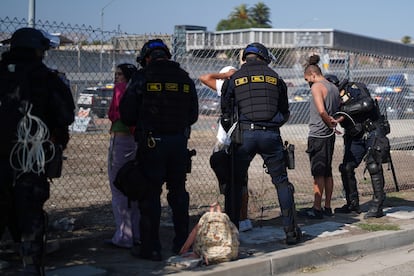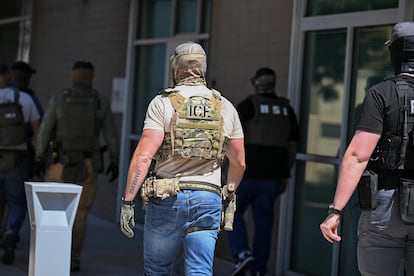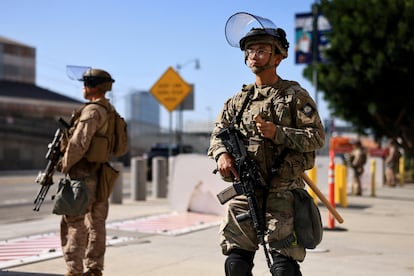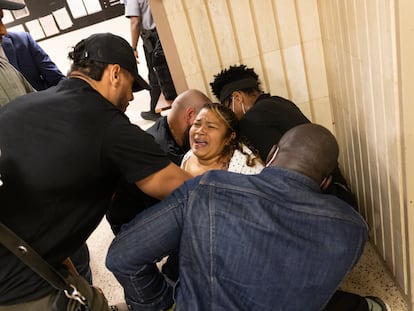All the security forces in Trump’s immigration crackdown: From ICE to CBP
Activists and relatives of detained migrants are struggling to identify who is carrying out arrests


Amid the Trump administration’s crackdown on immigrants across the United States, federal agents are operating undercover on the streets, in cars without visible license plates, often in plain clothes, and with their faces covered by masks. No one knows if they are Department of Homeland Security (DHS) officers, Immigration and Customs Enforcement (ICE) agents, or Homeland Security Investigations (HSI) members.
An example of this occurred last Thursday at the gates of Dodger Stadium in Los Angeles, California. The presence of armed federal agents — without uniforms, badges, or visible identification, and with their faces covered — sparked a reaction from dozens of protesters, who demanded the officers be removed from the building. However, Customs and Border Protection (CBP) clarified that the individuals were not ICE agents but their own personnel, and that they were not carrying out any law enforcement operation. Immigration agents typically wear vests labeled “ICE/ERO” or “Homeland Security,” with the name of their department printed on one or both sides of their vehicles — but that is not what is happening right now.

“When our heroic law enforcement officers conduct operations, they clearly identify themselves as law enforcement while wearing masks to protect themselves from being targeted by highly sophisticated gangs like Tren de Aragua and MS-13, criminal rings, murderers, and rapists,” said Tricia McLaughlin, deputy secretary of the Department of Homeland Security, in recent statements.
Who is who?
The best-known are U.S. Immigration and Customs Enforcement (ICE) agents. They identify, arrest, detain, and expel undocumented or irregular immigrants, but they do not act alone. They operate alongside Enforcement and Removal Operations (ERO) agents, who focus directly on threats to public safety, such as convicted criminal immigrants, members of organized crime, and individuals who have re-entered the country illegally after being deported. They also search for migrants who have ignored a federal judge’s deportation order.
Meanwhile, agents from Homeland Security Investigations (HSI) — which is also a branch of Immigration and Customs Enforcement (ICE) — are responsible for investigating crimes on a global scale within the U.S., abroad, and online. This government office conducts federal criminal investigations into child exploitation, human trafficking, financial fraud, and scams.

Other officials involved in immigration matters are the CBP agents. They work at ports of entry, such as airports or land border crossings. In this regard, the Border Patrol (as it is also known) conducts traffic checkpoints along highways, urban patrols, transportation checks, and anti-smuggling operations. They also monitor international borders and coastlines within their jurisdiction to prevent illegal entry and the trafficking of illicit drugs.
Finally, the National Guard and U.S. Marines have become involved in immigration matters, sparking backlash from both citizens and local authorities. Following the White House’s deployment of 2,000 troops to control protests against immigration raids and deportations that rocked California this month and spread across the country, the Ninth Circuit Court of Appeals ruled in favor of keeping the troops in Los Angeles under federal control, while California Governor Gavin Newsom’s objections are litigated in federal court.

For its part, the United States Northern Command stated that the Marines will now work alongside National Guard troops under Task Force 51. Air Force General Gregory Guillot told the Los Angeles Times that the Marines have limited authority and are deployed solely to defend federal property and staff. “They don’t have the power to arrest anyone,” he stated. Despite this, California authorities have strongly opposed their presence on the state’s streets.
Sign up for our weekly newsletter to get more English-language news coverage from EL PAÍS USA Edition
Tu suscripción se está usando en otro dispositivo
¿Quieres añadir otro usuario a tu suscripción?
Si continúas leyendo en este dispositivo, no se podrá leer en el otro.
FlechaTu suscripción se está usando en otro dispositivo y solo puedes acceder a EL PAÍS desde un dispositivo a la vez.
Si quieres compartir tu cuenta, cambia tu suscripción a la modalidad Premium, así podrás añadir otro usuario. Cada uno accederá con su propia cuenta de email, lo que os permitirá personalizar vuestra experiencia en EL PAÍS.
¿Tienes una suscripción de empresa? Accede aquí para contratar más cuentas.
En el caso de no saber quién está usando tu cuenta, te recomendamos cambiar tu contraseña aquí.
Si decides continuar compartiendo tu cuenta, este mensaje se mostrará en tu dispositivo y en el de la otra persona que está usando tu cuenta de forma indefinida, afectando a tu experiencia de lectura. Puedes consultar aquí los términos y condiciones de la suscripción digital.
More information
Archived In
Últimas noticias
The complicated life of Francesca Albanese: A rising figure in Italy but barred from every bank by Trump’s sanctions
Reinhard Genzel, Nobel laureate in physics: ‘One-minute videos will never give you the truth’
Pinochet’s victims grapple with José Antonio Kast’s rise in Chile
Half of Scotland is in the hands of 420 property owners
Most viewed
- Pablo Escobar’s hippos: A serious environmental problem, 40 years on
- Reinhard Genzel, Nobel laureate in physics: ‘One-minute videos will never give you the truth’
- Why we lost the habit of sleeping in two segments and how that changed our sense of time
- Charles Dubouloz, mountaineering star, retires at 36 with a farewell tour inspired by Walter Bonatti
- The Florida Keys tourist paradise is besieged by immigration agents: ‘We’ve never seen anything like this’










































